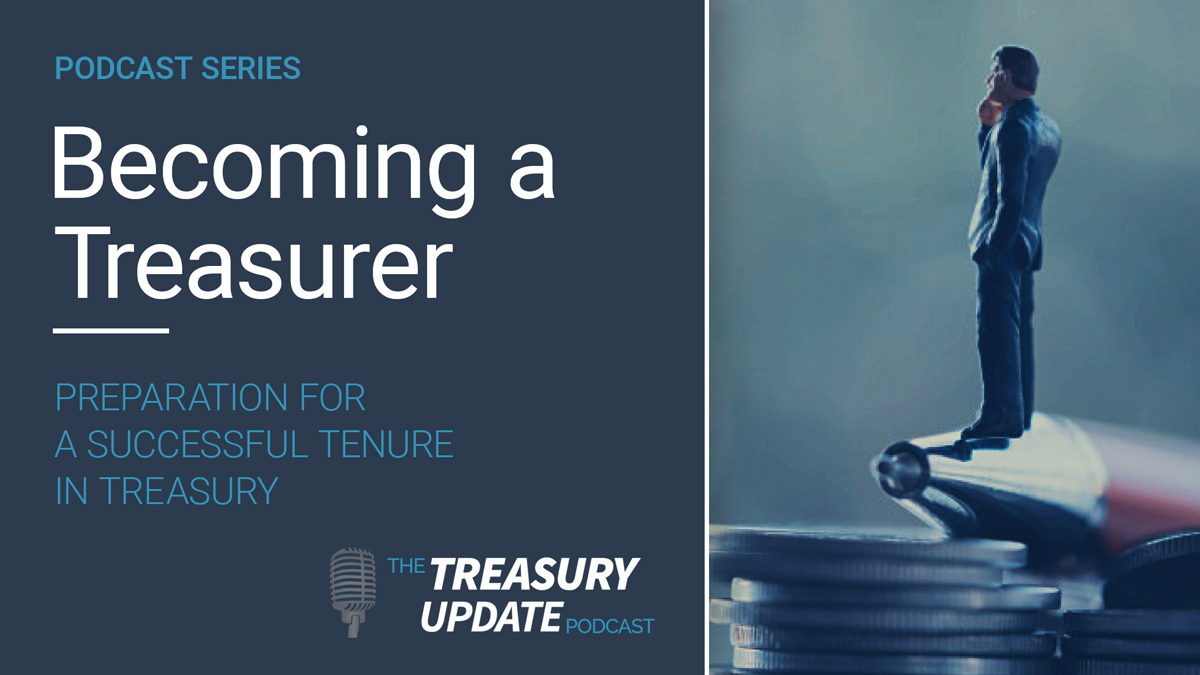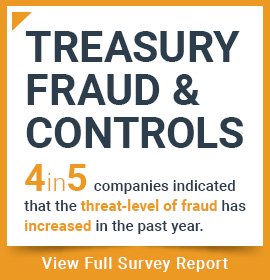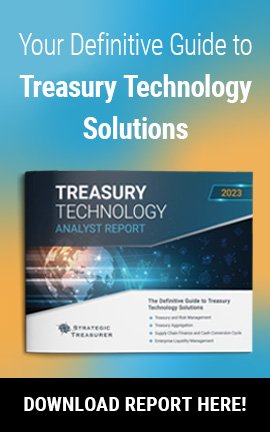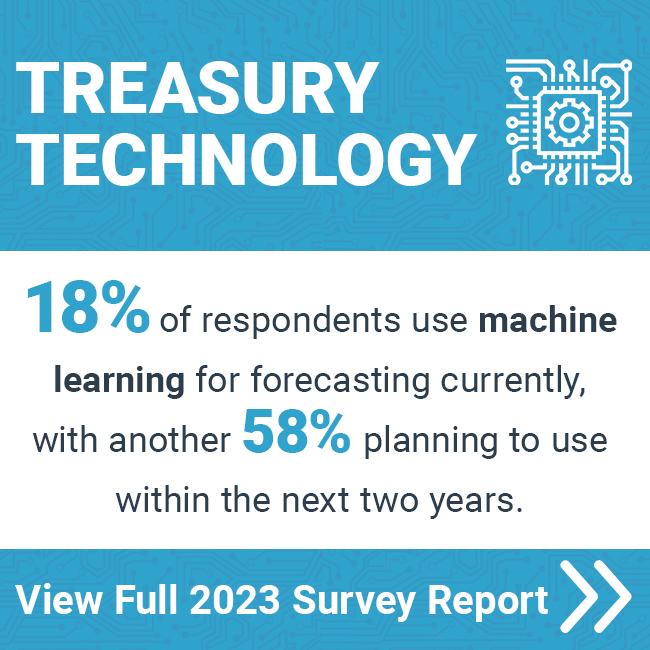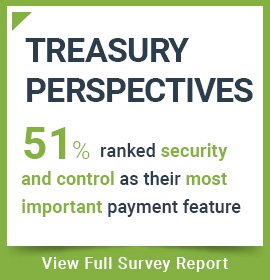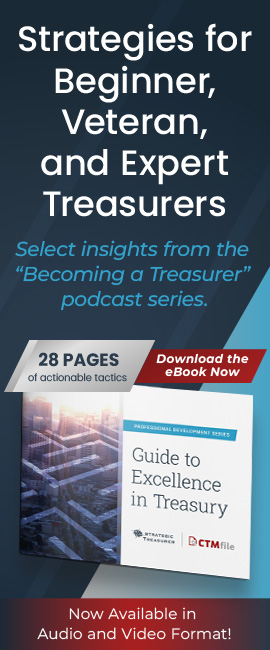
Episode 140
The Book of Alternative Data
On this special edition of the podcast, Host Craig Jeffery interviews author Saeed Amen on The Book of Alternative Data. They discuss methodologies and processes of leveraging non-traditional information sources in the context of investing, risk management and more. Listen in to learn the various uses of alternative data and how it can help you and your organization make better decisions.
Host:
Craig Jeffery, Strategic Treasurer


Speaker:
Saeed Amen, Cuemacro

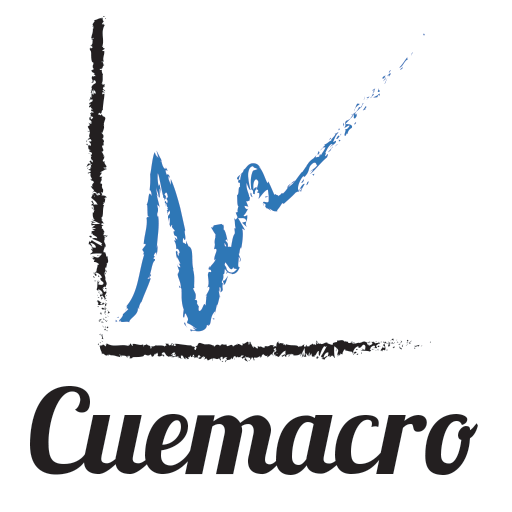
Episode Transcription - Episode #140 The Book of Alternative Data
INTRO:
Welcome to the Treasury update podcast presented by Strategic Treasurer, your source for interesting Treasury news, analysis, and insights in your car, at the gym, or wherever you decide to tune in. On this special edition of the podcast, host, Craig Jeffrey interviews author Saeed Amen and The Book of Alternative Data. They discuss methodologies and processes of leveraging non-traditional information sources in the context of investing risk management and more. Listen in to learn the various uses of alternative data and how it can help you and your organization make better decisions.
Craig Jeffery:
Welcome to the Treasury update podcasts Saeed.
Saeed Amen:
Thanks very much Craig for inviting me to be on.
Craig Jeffery:
With a title of Alternative Data and your book The Book of Alternative Data, I think it makes sense to describe what is AD broadly? What’s what is alternative data?
Saeed Amen:
So, with that said that’s a great place to start so, yeah Alexander Denim and I wrote about them alternative data in our book and the key part is first of all, as you suggested, define it. I say in the context of at least within financial markets, we tend to think of alternative data is being those data sets which are not typically used. So, if we think of data sets which are typically used within financial markets that say you’re trading stocks, the stock price as a data set is something that’s typically used. In terms of economic data events, things like GDP, that again, is a common data set that people would be using to trade, financial markets. But then, if we think about alternative data sets, this could encompass things which are not necessarily simply prices. And it could be things like satellite imagery to take pictures of car parks in parking lots to understand how well retailers are doing. It could be text data to text data say from newswires like Bloomberg, or Reuters, or from social media, things like Twitter, so anything which is not as commonly used, I would say, to compare to things like price statement.
Craig Jeffery:
So, who is this alternative data for? You talked about traders or equity activity are there other uses for it?
Saeed Amen:
Yeah, so there’s very many uses for it, the primary focus I guess within the book is to think about how you would come up with trading ideas and trade financial markets as traders. But equally I’d say alternative data is of interest if you’re a risk manager. If you’re trying to understand how to forecast risk, how to forecast volatility. An alternative data can be an input into your decision making to understand whether say the market is going to be more volatile on the coming period or less so, and so one example of that is, let’s say your risk manager and you have a big position on an certain stock or certain commodity if there’s a lot of activity on Twitter discussing this stock. That would suggest that the dance, you might have a more volatile period essentially, so more mentions is typically coincident with more volatility associate to an asset so, even if you’re not actually trading in your risk manager it’s important or let’s say you’re trying to reduce your risk if you if your corporate treasury. It’s important to understand what volatilities doing in the coming period.
Craig Jeffery:
So, the purpose of your book and I only have it digitally. I didn’t buy a hard copy book but that’s…so I can’t hold it up to show you and we’re doing this over zoom not in person. You know the purpose of the book, I think you describe it as to help people make better decisions, so what is the thinking behind this? How does this alternative data help us make better decisions? What are some of the elements of that?
Saeed Amen:
I think, is about having all the different data sets at hands to make a decision, so one thing that I do every day is I go walking. So, one way to make a decision is I’ll look at the weather forecast given by Google on an hourly basis, but in another important data set is looking out the window. So, if I don’t look out the window and I just look at the weather forecast I’m actually missing an important part of what’s going on. So, it’s the same thing with alternative data, you might be looking at certain date says like purity of the price or GDP or earnings and things like that. And that’s an important parts of constituent parts of how to make your decision-making process, but you could be missing other important things which are not visible in these traditional data sets, alternative data set is going to shed an additional lights on a situation might tell you some new information that’s not already contained within like common data sets that you look at. Essentially, so you’re trying to make better decisions but you’re looking at more disparate data sets essentially, and hopefully data sets that are meaningful, as well as the key when they need to be meaningful, for your use case.
Craig Jeffery:
In your book, you mentioned you’ve given number of good examples, one has to do with ADP the payroll company, for example. Do you want to explain that?
Saeed Amen:
Yes, certainly, that’s a good example actually, so there’s two types of use cases for all turn their one is if you’re a user let’s say you’re a trader or investor or you could be in the corporate you’re trying to understand your market. You’re trying to understand what your competitors are doing so you could use maybe credit card data to identify what spending patterns are and your competitors compared to yours, but the other side of it is corporates can also be suppliers of data, so corporates as part of their everyday business will be recording a lot of data dependent upon what their industries and so that is in the in the lingo in the industry we call that exhausts data, essentially. And so that exhaust data can be used internally, so if you’re a retailer to understand your own sales, but, equally, could be used externally as well, either to be sold, provided goes through the legal safeguards and that’s fine, but also to provide marketing, for your firm so.
Saeed Amen:
One example of this is ADP, so they do a lot of work and they collect a lot of data around payrolls in around the world. Obviously, on an individual basis that data is very private and it’s not something that you’d want to release externally, but once you aggregate that into the country wide level say, into the US that’s actually going to give you important information on the labor market in the United States, so every month essentially ADP produces aggregated number that’s become an important part of the economic data calendar and they release that to the market and people look at that to try and understand underlying trends in the US labor market. That’s given away freely to the market, but ultimately every time it’s mentioned in the press, every time it’s mentioned anywhere, then you have a ADP mentioned, so it essentially becomes like a marketing exercise to boost the profile. And so that’s another way essentially that corporates can monetize their alternative data sets one either through selling provide legally it’s okay to do that, but the other isn’t terms of the marketing benefits which could be quite substantial.
Craig Jeffery:
There’s a couple terms in your book that you use that are, I hope, become more mainstream, one is what you just mentioned, exhaust data, data that’s created just in the in the course of business that that’s taking place and the other is lag data. Can you explain why, you have a term like lag data and what that means?
Saeed Amen:
So, this has been particularly apparent over the past year, with the unfortunate events around coronavirus. And typically, when you have, say GDP data, or employment data, that’s going to be for the recent period, maybe like it might be quarterly data or monthly data. But typically, there’s going to be a lag between when the data has been recorded and when it’s released, essentially, to the public, and the difficulty that you found particularly around this period is that the economy has changed within days or weeks, essentially, so by the time GDP data is released has been released, because of lockdowns and so on and so forth, the data ends up being stale and it’s not really representative of what’s going on at the time of release. So, the idea is that alternative data sets can kind of plug that gap in our knowledge. So, one example of this has been the mobility indices that Google and Apple have produced and are now have freely available where they look at mobile phone movement essentially of individuals and aggregate that up, so you can immediately see what is the impact of lockdowns and then potentially the impact on movement and hence economic activity, so there you get up to date picture what’s going on broadly as opposed to waiting a few weeks, when you have GDP and that the data will be stale essentially. So, there’s two parts data, one is to tell you what’s happening now, that’s the key part, like a now cost, but if now has changed substantially then it’s not going to be quite as useful.
Craig Jeffery:
I like that. I want to spend a few moments talking on the treasure of view, you know treasures care about volatility, they care about understanding the volatile, they have they want to advise the business whether it’s on acquisitions or competitors. What do they need to think about here, you know, is this is this related to currency risks, interest rates, commodity price volatility, counterparty exposure? Any thoughts on that or how this would apply to treasurers?
Saeed Amen:
Well, the thing is for each of those use cases there’s likely to be different alternative data sets that are important, so in terms of commodities, let’s say you have, say a food company that will be taking in a lot of raw commodities in cocoa, sugar, etc. And you can use alternative data sets to understand what potentially harvests will be like in these areas, and also in, for example, energy commodities as well. Let’s say you’re an airline company and you’re buying kerosene, to try and understand when you might get disruptions in crude oil flow because of shipping activity and things like that. Each of these different use cases could potentially having different alternative data set to give you kind of a bit of a heads up and insights into what’s happening essentially. And so, they’re not necessarily speculating on the price, but they need to know if there’s going to be any service disruptions or shorter supplies, and which could potentially push up costs.
Craig Jeffery:
Yeah now, you know as people look at forecasting, treasurers they forecast, they want to run different types of models, they care about the future, they may care about changes in the business environment, or the business cycle shifts or what competitors are doing. So, it seems like there’s some applicability there. Do you have any examples for that or am I right on that?
Saeed Amen:
Yeah so, the example I mentioned briefly before on competitive analysis is very important, so you might be a retailer essentially and you’re noticing of the spend of your customers is going down individually and you obviously have data yourself. But then, if you look at credit card data which you can purchase, which has been obviously anonymized. You can understand on an up-to-date basis how credit card spending is maybe affecting your competitors. So, if it’s only going down at your firm but your competitors are holding firm, then obviously there’s something specific to your firm that you can potentially improve. If it’s something where to industry wide issue over say the past few weeks, then potentially that’s something that also needs to be flagged as well, so again, this is not about trading financial markets or anything like that it’s just the facts understand your competitors better and then here alternative data could be quite important in this context.
Craig Jeffery:
You know we’ve talked on the podcast at different times about how data is exploding, there’s massive quantities of data everywhere from the Internet of Things, to just to, you know, this more than doubling every couple of years of data, and so that that’s part of that background, I think, for The Book of Alternative Data and the concepts here that data is there’s tons of data, how do you filter through it and then there’s this increased rise or expectation of financial professionals to manage risk. You know, I guess, when you think about that is not every data sets useful, how do we cut through this, how do we figure out what’s important?
Saeed Amen:
Well, one thing that Alexander and I we wrote in the book was to have a checklist and it’s actually quite common if you talk to people with an alternative data space to initially have some sort of checklist. So, what type of assets are you interested in looking at, first of all, so if you let’s say you’re following Apple very closely, you might want to try and find data sets which look at estimations of, say iPhone sales in different countries, maybe web traffic to apple the number of Apps Apple downloads etc, so that those data sets will be very specific if you’re looking at another stock say something like. I don’t know say a construction company, any data set related the iPhone sales that it might be useful and abroad basis for economic cycle, but it’s not going to be quite as relevant as it is, if you’re trading Apple stock directly so try and think about data sets are relevant to your use case center and the assets that you have trading. So that’s one way that’s one thing on your list. Also, to try and understand the cost of the data set as well, so what is the cost of the data versus the potential upside for you have, knowing that information, and if a data set costs half a million dollars what you think you can you, you can only make $200,000 from it, that’s obviously not a good example. So typically, people try and like within the industry is a ballpark like are people thinking like a 10 times return. So, if you spend $10,000 on a date so you hope to make maybe $100,000 or something like that. And, it admittedly it’s quite difficult to quantify this number unless you’re like systematically trading. There you can just about trying to quantify that number, but if you’re doing more in terms of general decision making is more difficult to do that, but I would advise having some sort of checklist to at least discount data sets immediately. Because it’s going to take a lot of time and effort to go through data and once you once you trial it so you can’t trial every single data sell in the market there’s thousands and thousands of all. I think it’s probably at these one or 2000 alternative dates that’s out there at the moment.
Craig Jeffery:
Now, this this checklist idea of seeing what assets, can be used. Part of that discussion ties into your concept of what a concept of a robust signal you know this data provide some type of signal, what’s robust what’s relevant? What will give you a robust signal?
Saeed Amen:
I think one way to try and understand the robust signal is to try and look at the historical performance of signal, so obviously past performance is not a guarantee of future performance, like I’m sure we have to say that as a disclaimer, but it can at least give you some sort of insight into the future, and also to try to join together different sorts of data sets. If we give the example of the retailer, we can have a date set that looks at satellite imagery of car parks, we can also maybe look at location data from mobile phones, we can also look at website traffic to that retailer. We could look at credit card data as well, so each of these data sets will, hopefully together, give you a more accurate signal to try and understand earnings versus one of them individually. So, this idea of augmenting together combining different data sets together, I think that’s the really powerful idea. You might find that one specific data set is not going to give you that much information, but the cumulative effect of several different approaches are going to actually going to help it’s just like I like running, for example. There it’s all about training. So, you want to be able to train for long distances and also for speed and if each of these brought to your game and you’ll be a better runner ultimately.
Craig Jeffery:
So, on this retailer and looking at something like the satellite image of the car park or parking lot and you see maybe it’s moved from three quarters full to half full. Is that…that might provide some insight. Is there fall off on that, but in this shelter in place or COVID environment, maybe there’s more online deliveries or something so you, you might use multiple sets of alternative data.
Saeed Amen:
Yeah, essentially so then, then you would need to try and understand a website traffic or credit card transactions, so hopefully together each of these will cancel out some of the issues of the other essentially.
Craig Jeffery:
As I’ve been reading them the alternative date and you and I have talked a little bit is the value of alternative data to make better decisions, and maybe this is a wrong contrast but is it more because there’s another view you know additional perspective on what’s happening? Or is it more because you might be able to see something earlier something more current you know, like, if you look at the overall economy it’s, this gives an indication a week ago versus two months ago from government statistics is a more timing or completeness of picture.
Saeed Amen:
I think it’s both actually it’s both it’s one trying to get an idea of what’s happening quicker than official data and the rest of the market. But, also, trying to build up a more complete picture as well, so yeah, I would say both facets of that. Ultimately, if everyone uses the same alternative dates that then potentially over time that edge will kind of decay. But the flip side, then, is if you’re one of the few people that don’t connect, you’ll have a blind spot essentially so. Yeah, alternative data, I think, at least at least, to begin with you wanted to have an edge, but later on data sets become more could commoditize you kind of have to look at it, because everyone else has access to.
Craig Jeffery:
So, you’re sort of defining what’s the alternative to using alternative data it’s falling behind not having the edge to falling behind.
Saeed Amen:
Yeah, I would say so, you don’t want to you don’t want to end up falling behind essentially, if other people are using the same data sets. Because any sort of data or technology you to begin with you have the early adopters but then later on, it becomes more commoditized and then more people will use it.
Craig Jeffery:
Now, with sometimes when I think about data, I think of it all and tables or relational database that’s not always the case. When we spoke a little earlier, you talked about you know figuring out what the Fed is doing and what they’re saying to their statistics. You mentioned ways of getting at the data I think you’re discussing natural language processing or NLP on that.
Saeed Amen:
Yeah, sure so it’s a product data product, but my firm Q Macros trade and so. Essentially, we look at the various fed speeches, the minutes and so on, and typically economist will read these to get an idea of what the Fed is likely to be doing in the future. But the idea here is we do this on a systematic basis and essentially read all of these texts, I guess, over the past 25 years. And then apply natural language processing to come up with a specific sentiment score, and so the idea, there is we’re trying to give you a kind of a quantitative way to interpret what is typically qualitative views within Fed statements and speeches, and to do that in a in a systematic way essentially so you’ve got a 25-year history of relative Fed sentiment looking at what they’ve been saying to the market and to the public.
Craig Jeffery:
As we, as we finish up, are there any other points that you want to leave the audience with or maybe a point you want to emphasize for people to take away?
Saeed Amen:
I say, the key point is that, over time, I think it’s going to be a necessity to look at alternative data and because you don’t want to get left behind essentially, and not doing anything could put you at a disadvantage and the parallel I would give is within like corporate treasury, is it FX hedging so I’m basically a currency guy, so that’s where my main focus has been over the past few years, but then you have the same thing and that’s, you can choose not basically choosing not to do a hedge could give you exposure to more risk. So, not doing anything can actually be riskier than doing something. So, I’d say the same issue is also potentially you could see that with alternative data in the next few years, so it’s important to get ahead of the curve and get into space now rather than 10 years in the future when it’s probably a bit to be too late to get into.
OUTRO:
You’ve reached the end of another episode of The Treasury Update Podcast. Be sure to follow Strategic Treasurer on LinkedIn. Just search for Strategic Treasurer. This podcast is provided for informational purposes only and statements made by Strategic Treasurer, LLC on this podcast are not intended as legal, business, consulting, or tax advice. For more information, visit and bookmark strategictreasurer.com.
Related Resources
Check out our YouTube playlist covering many frequently asked questions in treasury!
This series within The Treasury Update Podcast explores questions around being a successful treasurer. Topics discussed include preparation, what needs to be measured, effective communication, development of a team, and acquirement of resources needed.

